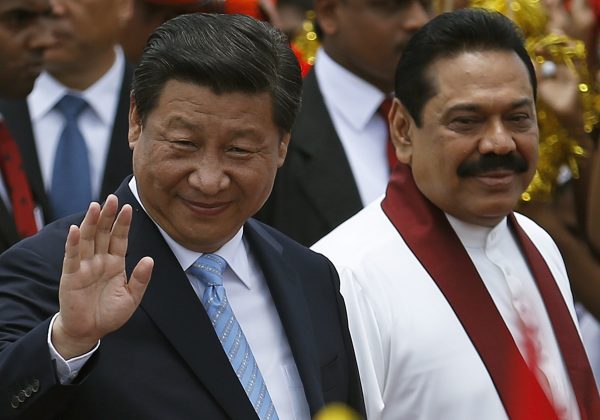But how much influence over these countries’ choices and policies does China actually have?
China has cultivated apparent patron–client relationships with small peripheral states that can play ‘spoiler’ roles in regional initiatives. Cambodia and Laos played this role within ASEAN in 2012 and 2016 to forestall a collective stance on the South China Sea territorial disputes with China. Politically motivated Chinese trade deals, favourable lending and targeted investments in surrounding developing countries help Beijing to buy favour and cultivate dependence.
In contrast with the United States’ security-focused approach, China’s intensifying ties with Asian developing countries privilege their shared developmental imperative — the strong commitment to generating economic growth and development — as the key means to ensuring the domestic legitimacy and therefore sustainability of the ruling regimes within these states.
China’s security relations with these neighbours are therefore more explicitly nested within wider political and economic relationships. The economic relationship is also more strategically pliable because state-owned enterprises spearhead Chinese regional investment, in contrast to US, Japanese or South Korean private investment.
When analysing the impacts of China’s rising influence on the regional order, there are five key aspects that must be considered.
First, there are not many cases in which Beijing tries to make its smaller and weaker developing neighbours do what they otherwise would not have done. Instead China exercises its power by leveraging shared economic development imperatives and meeting many of these governments’ demands for quick and non-transparent bilateral investments. So China’s influence often results in more continuity than change: rather than being revisionist, China often mobilises and reinforces these developing states’ existing preferences.
Second, in taking a developmentalist approach, China’s broader strategic intent is to invest in its future influence in Asia. Since the mid-1990s Beijing’s consistent aim has been to foster stability in its immediate periphery and promote economic growth opportunities to ensure the security of its regime and support efforts to recover its international position and status. Avoiding attempts to coerce its small neighbouring states helps China mask the risks associated with its growing resources and hoard goodwill as a hedge against future opposition.
Third, China does not easily achieve what it wants — even with these weaker states. Instead, the extent of China’s influence tends to depend on these neighbours’ domestic dynamics. It can be undermined by various unintended consequences. Competing political actors and interest groups in these states can facilitate or resist Chinese interests. Some leaders actively courted Chinese investment and attention rather than the other way round. Others exploit Chinese resources to diversify their strategic options and still manage to resist Chinese pressures on key national issues.
Fourth, the systemic impact of China’s growing power in developing Asia is also constrained by broader structural conditions. International institutions and rules — such as the Bretton Woods financial institutions and the United Nations — are still dominated by the West. Such constraints may be a broader phenomenon associated with the entrenched postwar US-led Western liberal order, which is either too attractive or too costly to replace entirely.
The final constraint lies in the way China practises its power. Chinese policymakers and analysts seem to have two blind spots about their small developing neighbours. The first is a tendency to downplay the autonomous agency of these weaker states, preferring to attribute their lack of acquiescence to the machinations of other great powers. The second is to overlook the connection between China’s more benign modes of influence and the undermining effect of its at times inconsistent or coercive behaviour on the very same issues.
Both of these problems are especially acute in the South China Sea territorial disputes. Chinese policymakers have tended to read the toughening stances of their smaller rival claimants as having been instigated by the US ‘rebalance’ to Asia, rather than as nationalist responses to Chinese assertiveness in bilateral conflicts. Chinese analysts, policymakers and public opinion are experiencing a dissonance between their growing material power and their perceived lagging status, influence and effectiveness in the international realm.
It is by no means clear that Beijing is easily able to win over developing countries to which it can promise quick credit and cheap infrastructure. If power transition theories are correct, the growing sense of frustration with the ‘influence gap’ among Chinese leaders may foreshadow that dangerous point when a rising power is intensely dissatisfied and may challenge an incumbent. For this reason alone, China’s growing strategic developmentalist agenda throughout Asia merits sustained attention alongside the intricacies of its strategic relations with the US and other major powers.
Evelyn Goh is the Shedden Professor of Strategic Policy Studies at the Strategic & Defence Studies Centre, ANU, and editor of Rising China’s Influence in Developing Asia (Oxford University Press, 2016).
An extended version of this article appeared in the most recent edition of the East Asia Forum Quarterly, ‘Reinventing Japan’.


Thanks for an interesting analysis of the dynamics operating in the interactions between China and its neighbors.
The issue of the autonomy (nationalism?) of its smaller neighbors is one that I find particularly relevant. It seems as if Vietnam and Indonesia in particular are trying to resist the Chinese efforts to increase its power in the SCS. Is this what is motivating the mercurial President Duterte of the Philippines in his recent proclamations of his desire to distance himself and his country from the USA?
‘China has cultivated apparent patron–client relationships with small peripheral states that can play ‘spoiler’ roles in regional initiatives’.
Peripheral countries have cultivated a tributary relationship with China for a thousand years and they’re returning to that successful model as China is returning to world leadership.